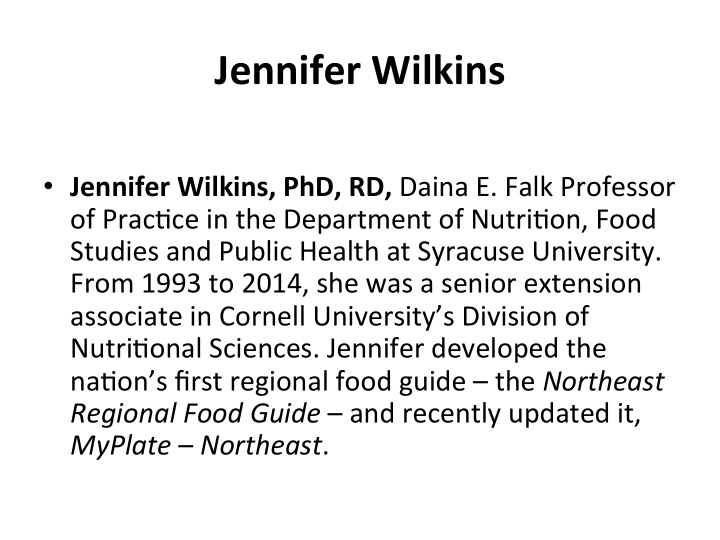



Jennifer Wilkins • Jennifer Wilkins, PhD, RD, Daina E. Falk Professor of Prac2ce in the Department of Nutri2on, Food Studies and Public Health at Syracuse University. From 1993 to 2014, she was a senior extension associate in Cornell University’s Division of Nutri2onal Sciences. Jennifer developed the na2on’s first regional food guide – the Northeast Regional Food Guide – and recently updated it, MyPlate – Northeast .
Kate Clancy Kate Clancy is currently a food systems consultant, Visi2ng Scholar at the Center for a Livable Future Johns Hopkins University School of Public Health, Adjunct Professor at TuUs University, and Senior Fellow in the Minnesota Ins2tute for Sustainable Agriculture, University of Minnesota (she resides in University Park, Maryland).
MyPlate Northeast & Dietary Guidance
Sustainable Diets – FAO Defini2on “Those diets with low environmental impacts which contribute to food and nutri2on security and to healthy life for present and future genera2ons. Sustainable diets are protec2ve and respec^ul of biodiversity and ecosystems, culturally appropriate, accessible, economically fair and affordable; nutri2onally adequate, safe and healthy; while op2mizing natural and human resources”.
Defining diets Diet ~ Food consump<on • Foods & beverages • Capaci<es – knowledge, skills, resources, <me, health, lifestyles • Food prepara<on • Meal paFerns • Ea<ng prac<ces – social contexts, ea<ng home or away • Food access / supply – community food security
Various home-based “food systems” • Foods • Cultural iden22es of foods; histories and • Meals tradi2ons, • Dishes and courses • Food science • Recipes • Ea2ng prac2ces – • Food prepara2on breakfast or dinner • Kitchen • Household make-up and • House lifestyles • Stove or fridge, utensils • Food availability / access etc. • HH Resources • Recipes
Typical ‘food system’ diagram
Systems nes2ng / scales
Sustainable food systems for whom? • Sustainability of what & where, for whom? People, communi<es, countries, governments, corpora<ons • Present vs. future genera<ons • Local vs. global • Rich vs. poor na<ons • Wealthier vs. poorer residents and neighborhoods • Owners and farmers vs. farm and food laborers
Session major ques<ons • How can consuming regionally-produced foods address food security and food jus<ce? • How can enhancing regionally produced foods in the marketplace influence food jus<ce and food security? • Are there par<cular NE food choices that could influence food jus<ce and food security more than others? • What could My Northeast Plate incorporate this guidance?
Our Focus - connec<ng : • Food security and food jus2ce. • NE MyPlate - regional food supply / sourcing. • Diets, ea2ng choices. • Guidance – recommenda2ons on making food choices from the Northeast that support food security and food jus2ce.
Please suggest: • What guidance can emerge that links these issues to diets? • What are some challenges to formula2ng such guidance – e.g., complexi2es, contradic2ons, lack of informa2on?
Recommend
More recommend